You must learn to work with the cards you're dealt
Serendipity
I remember a time in Africa 12 years ago when, on the way back from an exhausting day's worth of photography in Botswana (I seem to remember chasing a monitor lizard at one point), my late mentor and noted adventure photographer Galen Rowell suddenly woke from a car nap and began yelling at the driver to stop. While I noted the big orange ball of sun in front of us nearing the horizon, I looked around excitedly for the exotic animal that Galen must have spotted. For Galen to be so emphatic, it must be something great. Cheetah, perhaps? Black Rhino? What? Where was it? What was it doing? Could we get whatever it was against the sunset in time?
Galen frantically dug through his gear and pulled out a body, lens, and tripod, walked a short distance from the vehicle and started photographing...nothing but the sunset. Now, to put this into perspective, we were in a rather non-descript area a long way from any of the small villages, we were on an ugly dirt road lined with trees that had seen better days, and there wasn't an animal in sight. The locale was so awful photo-safari-wise, that out of 14 photographers, Galen and I were the only ones who pulled out our equipment and got out of the vehicles looking for a photo, despite the brilliant ball of orange in front of us. Just as I got my camera framed on the sun setting exactly between two trees down the road, along came a jeep, coming right out of the sun and throwing up dust to make a dramatic silouette that lasted all of about three seconds. I got off a photo, then ran into a nearby field and found a termite mound to frame against the setting sun. Another decent photo.
As Galen and I walked back to the vehicles in the fast-gathering dusk, I asked him "why the urgency?" Galen looked at me and replied "You only get one sunrise and one sunset a day and you only get so many days on the planet. A good photographer does the math and doesn't waste either." He pointed out that I now had a photo that none of the others in the group had, and that I wouldn't have taken that if I just sat in the vehicle and watched the Sundown Show. He went on to give me some advice: "Most of my best sunrise or sunset images were taken because I planned to be there. Sometimes I had to go back multiple times to get the photo, sometimes I just happened to see a cloud and knew where I needed to be when the light changed. But even if you don't have a plan, there's always serendipity. Look around and find the thing that stands out. Couple that with some photographic skill and a little physical ability, and almost every sunset can provide you something to photograph."
Redux
Two weeks later I was in a boat on the Chobe River. I suddenly realized that the sun was setting behind me and I hadn't planned anything (I hadn't realized that I'd still be on the boat when the sun set; technically, park requirements said I should be back at the dock by now, but I lost track of time somewhere). The boat was heading away from the sun, so I moved to the back of the boat. As luck would have it, a local poled by in his dugout just as the last rays of sun were visible:
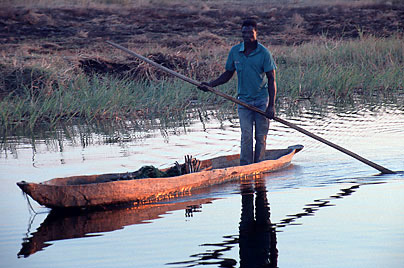
But since I couldn't really position our boat—the driver wanted to get back to the dock before the park service got mad at us—I couldn't get the sunset behind him. Then I noticed the patterns his boat and ours made in the water, and after a few moments of fiddling, I produced this photo:
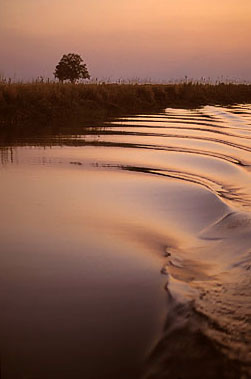
I have a few things to say about this photo. First, for reasons I'm still not completely sure of, I like it a lot. I think one factor is sentimental: this was one of the first photographs I took upon retaking up photography where it's all about mood and feeling, something that's not easy to capture. The photo has a simplicity, quietness, and sureness to it than mimics what I felt at the time. It's also not like any other photo I took that week, which says something important, as well: I was pushing myself beyond what I would normally do. I was using my skills to capture what I envisioned and what I felt, not simply trying to record what was in front of me.
Some may say that there's a better horizontal image here (to see it crop a bit of sky and the entire bottom half of the image). I actually took that photo, too. But I didn't like it as much as this one, because there's another thing going on here: this part of Africa seems to extend to foreever and can seem so barren and empty, yet so full of color and detail. Anyhow, whether you like the photo or not isn't the point. The point is that I was fully cognizant of what Galen had said at the start of the trip, and I was trying to put that into action. And it produced an image I liked that I wouldn't have taken otherwise.
Practice, Practice, Practice
Okay, so now let me take you through a modern day version of that same set of lessons. It happened at one of my Hawaii workshops in 2002. After the long day of driving—and occasionally stopping to photograph—from Kona to Volcano House, I was dog tired and made the silly decision that we'd simply check in, pop out onto the veranda and see what was happening at sunset (where was Galen to kick me when I needed it?). However, I did note as we drove up to the hotel (which is situated on the edge of a caldera) that some sort of front was coming up over Kilauea and the cloud pattern was getting more interesting. By the time I checked in, took my bags to my room, unpacked a few things, and came back down to the veranda, this is what I saw:
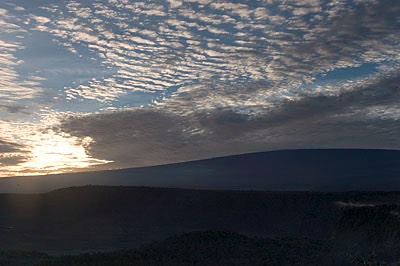
The workshop students weren't quite sure if this was going to get better, but having been here a number of times before, I knew that the sun had a pretty good chance of getting underneath all of the clouds on the other side of the volcano and producing a light show. We were all tired, but I got out my camera and encouraged them to do the same. Within a few minutes the sky changed dramatically:
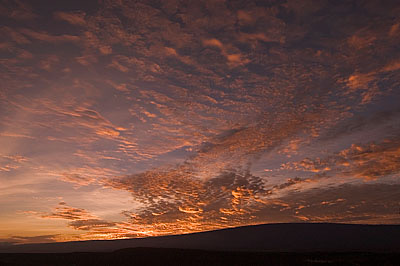
Okay, so now what? If you know anything about the location of Volcano House, you'll know that you don't have a lot of convenient options compositionally, despite the nice view. Once light leaves the caldera floor, it's difficult to include it. But I gave it a shot, anyway:
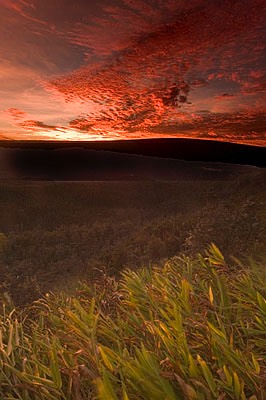
Like I said, not much light in the caldera, and given the properties of digital cameras of the time, it was very difficult to keep any detail in the dark area. So I decided it was time to experiment. One of the things I advocate students do is to break the basic rules of composition. So I tried breaking one (Horizons must be Horizontal):

Feel like you're in a plane spiraling to your death in space? So do I. But looking through the viewfinder dispassionately at this started to tell me what was wrong: other than the sky, we have nothing of interest. And even with the sky, we have no sense of place, whatsoever. I eventually noted that there were intermittent puffs of smoke out of the caldera:
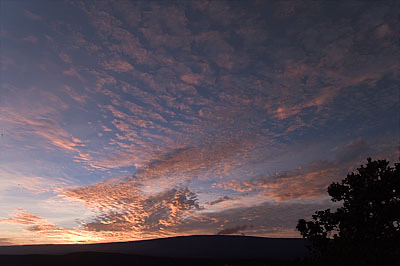
In order to get the smoke visible (it's just to right of the peak of the land silhouette), I've had to do a bit of postprocessing. Here I've downplayed the color temperature a bit to bring back some blue to the sky, then increased the luminosity of this whole area a bit.
In the end, though, I couldn't quite get the photo to be about anything but the sky, so I finally went with that, and produced this image:
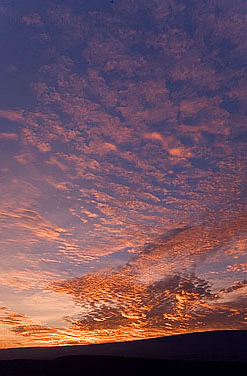
I've taken better images than this, by far. And there's no sense of place. So why did I take it and what did I learn? Well, it was the only sunset that occurred that day (as Galen would say) and I didn't let it slip away unseen and un-experimented upon, despite my poor location choice. But more important, I've now seen this cloud pattern several times at Volcanoes National Park, and I've done a bit of scouting to figure out how to get a sense of place into my photo when it happens again. So, next time I'm in Hawaii, I'll be keeping my fingers crossed that the pattern repeats yet again. This time, I know exactly where I'll be if it does.
Great photos don't happen by chance.